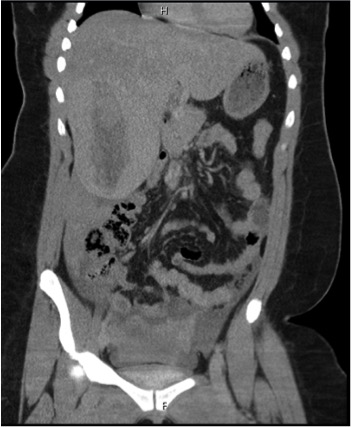Case Presentation: 26-year-old woman presents with abdominal pain for one day. She developed sudden, sharp and constant abdominal pain in the right upper quadrant and epigastric area. The pain is associated with subjective fevers, nausea and non-bilious, non-bloody vomiting. Pain is worse with deep breathing and movement. She denies weight loss, no diarrhea or constipation, no alcohol use, no change in quality of urine, no yellow skin or rashes, no pruritus, and no recent travel. Medical history is notable for migraines. Home medications include an oral contraceptive pill and Topamax. She has no known drug allergies. Surgical history is significant for breast reduction surgery. There is no family history of malignancy. She denies illicit drug use, never smoked and drinks occasional wine. She works as a secretary. She is single and has no children. On physical exam, her temperature is 98.7°F, blood pressure 137/79mmHg, heart rate is 109 beats per minute. She has a respiratory rate of 18 and oxygen saturation of 100% on room air. She appears to be in mild distress, clenching her abdomen. Her sclera were anicteric. She had poor inspiratory effort, limited by the abdominal pain. She was tachycardic and abdominal examination was notable for diffuse non-localizing tenderness to palpation with guarding, she had normoactive bowel sounds. Laboratory results are white blood cell count of 19, hemoglobin 9.0, platelets 381, 000, lactate 1.0, creatinine 0.86, ALP 83, AST 160, ALT 341, total protein 5.6, albumin 2.7, INR 1.1. A CT abdomen noted a possible hepatic mass. MRI abdomen with and without contrast showed a large mass in the right lobe of the liver with evidence of hemorrhage, most consistent with a ruptured adenoma. She underwent a partial right hepatectomy and cholecystectomy due to adhesions and proximity of mass to the gall bladder. Pathology of the mass confirmed hepatic adenoma that was beta catenin negative. She recovered well and was counseled on oral contraceptive pill discontinuation.
Discussion: This case highlights both the rare association of oral contraceptive pills with hepatic adenoma formation and the life-threatening complications associated with hepatic adenomas. Hepatic adenomas account for only 2% of liver neoplasms, more common being metastases, hepatocellular carcinoma and hemangiomas. While hepatic adenomas are found to occur in one in one million non-oral contraceptive pill users, its incidence rises to 30-40 in one million oral contraceptive users. The pathophysiology of oral contraceptives leading to hepatic adenomas is not well understood but may be related to estrogens acting on steroid receptors on hepatocytes leading to hyperplasia. Hepatic adenomas are clinically significant due to their risk of potentially fatal complications. Complications include intratumoral hemorrhage, rupture with intrahepatic hemorrhage and/or hemoperitoneum, and malignant transformation in tumors with beta catenin activated mutation.
Conclusions: It is important for hospitalists to recognize the association of oral contraceptive pills with formation of hepatic adenomas in order to provide appropriate counseling once an adenoma is discovered.

